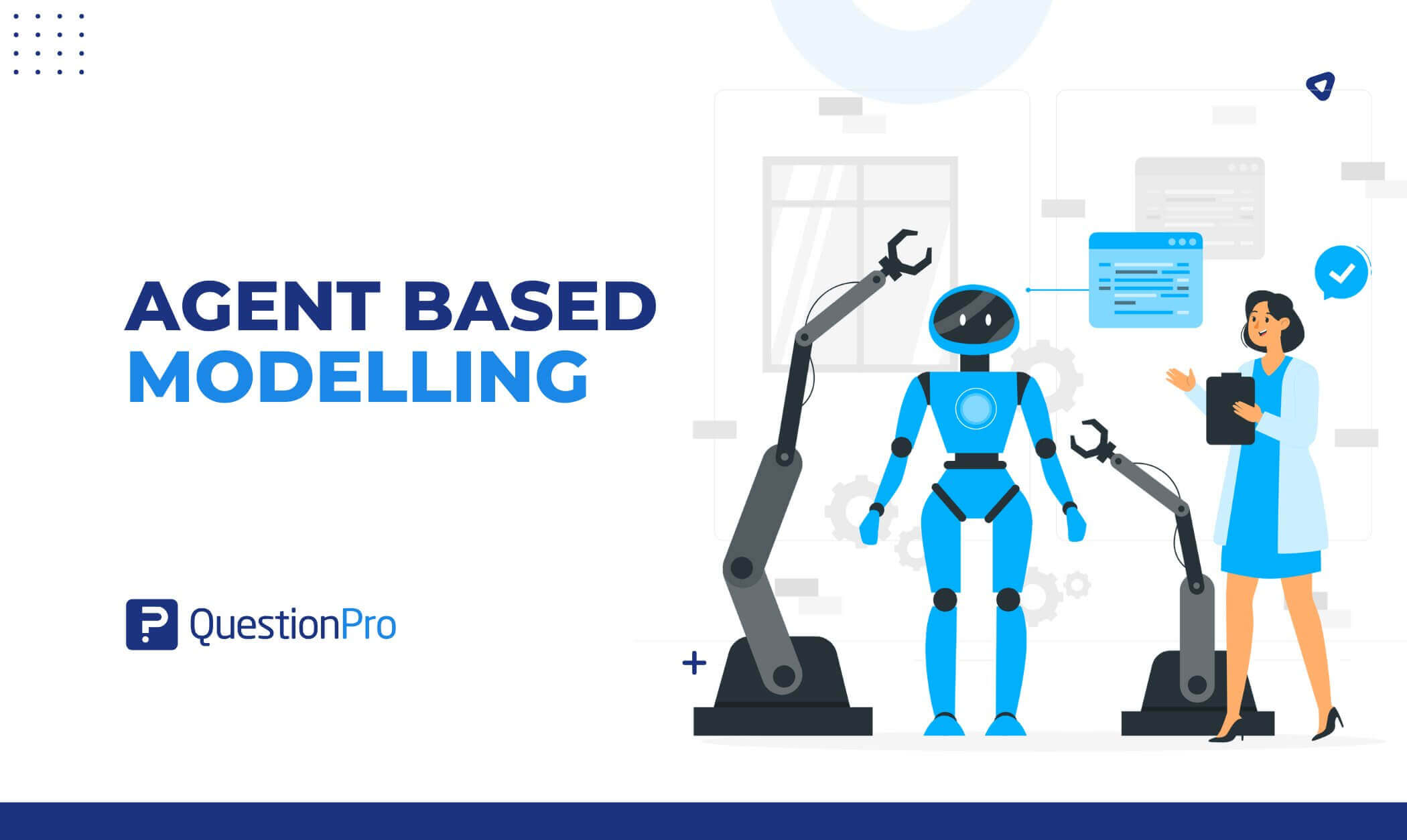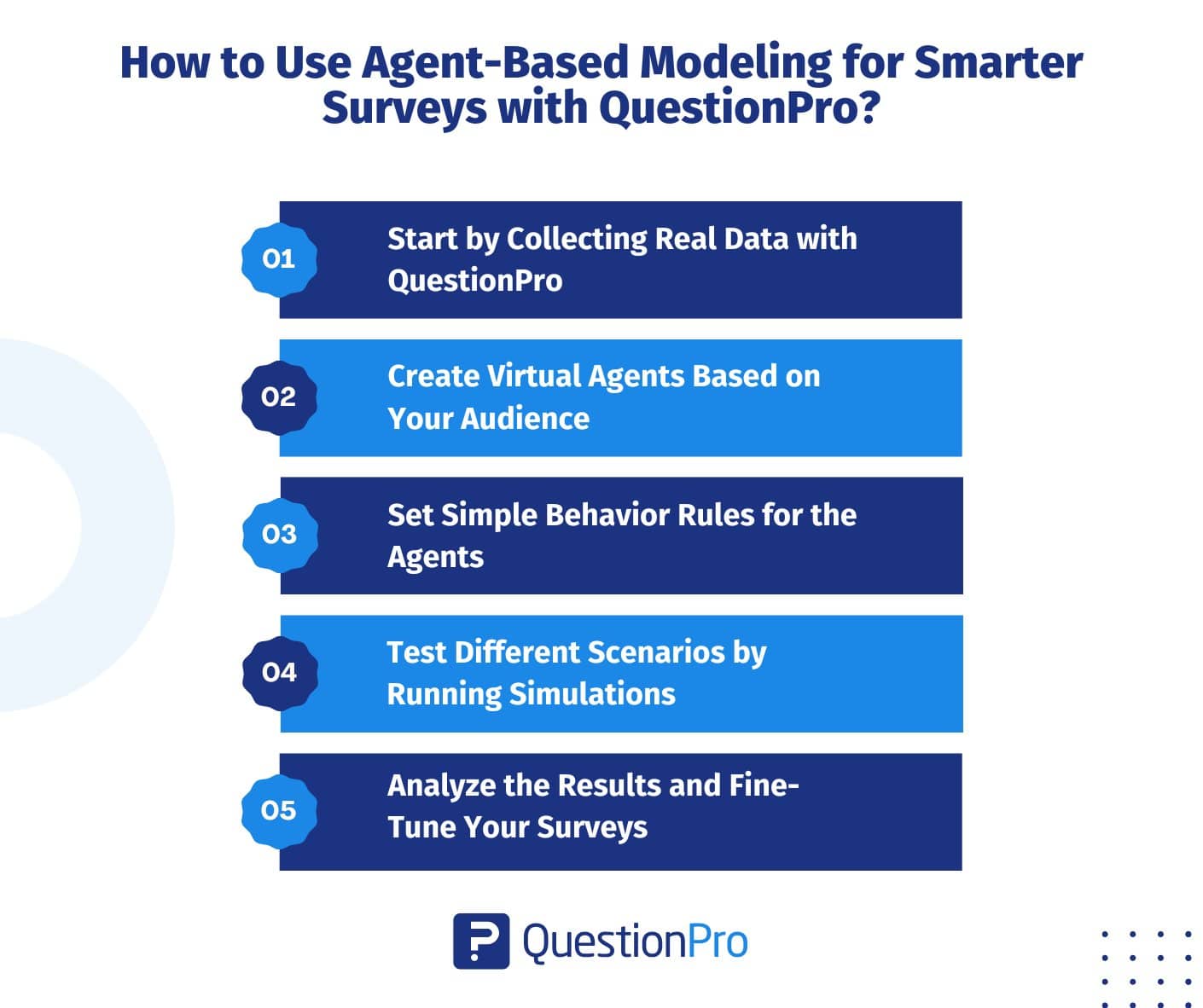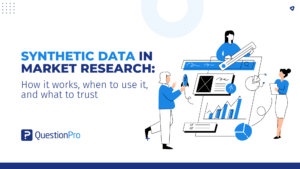
Running a survey seems simple: ask questions, get answers, analyze results. But people’s responses are influenced by many factors like friends, trends, or even question wording, and can change over time. So, how do you prepare for that? Agent-Based Modeling (ABM) helps by creating realistic simulations of how people might truly respond.
It gives you a way to create virtual “respondents” who act and think like real people. These digital agents can interact, influence each other, and even change their minds, just like people do. With ABM, you can test different survey scenarios, see how responses might shift in real-life situations, and spot patterns you’d likely miss with traditional methods.
In this blog, we’ll break down how ABM works for surveys and how it can help you predict, prepare, and fine-tune your research like never before.
What is Agent-Based Modeling?
Agent-Based Modeling (ABM) is a way of creating virtual simulations where each person, called an “agent,” acts like a real human. These agents have their own thoughts, behaviors, and ways of interacting with others.
In survey research, this means we can build a digital version of our target audience, like virtual survey respondents, and watch how they behave in different situations. These agents can answer questions, influence each other’s opinions, or even change their responses based on certain factors, just like people do in real life.
For example:
- What happens if people discuss a product before answering a survey?
- How do group opinions affect individual responses?
- How might responses change over time with new information?
With Agent-Based Modeling, researchers don’t have to guess. They can create different scenarios, test ideas, and see possible outcomes before launching a real survey. It helps in understanding complex behavior patterns that simple surveys may not fully capture.
ABM brings surveys to life by making them dynamic, realistic, and better at predicting how people truly behave.
How Does Agent-Based Modeling Work for a Survey?
Describing Agent-Based Models is like building a virtual world where each person, called an “agent,” behaves like a real-life survey respondent. Instead of just looking at numbers and statistics, ABM helps researchers see how individuals and groups might actually think, react, and influence each other when answering survey questions.
Here’s how it works in a survey context:
Designing Virtual Agents
Researchers start by creating digital agents that represent real people. These agents aren’t random; they are modeled based on data like
- Age
- Preferences
- Habits
- Social background or
- Past behavior
For example, an agent might be a 30-year-old customer who prefers online shopping.
Setting Up Behavior Rules
Once researchers create virtual agents for a simulation, they need to decide how these agents will act. This is called setting behavior rules.
Think of behavior rules as simple instructions that guide each agent’s decisions. These rules define how an agent will answer a survey question, how it might change its opinion, or how it reacts when influenced by other agents.
For example:
- An agent may always give honest answers based on its personal preference.
- Some agents may be easily influenced by others and change their responses after interacting with fellow agents.
- Others might ignore outside opinions and stick firmly to their own views.
These rules help create realistic behaviors within the agent-based simulation. By setting different behavior patterns, researchers can see how various types of people might respond in real life. It also helps them test how opinions spread, how group behavior forms, or how certain survey questions could affect answers.
Allowing Interactions Between Agents
Just like in real life, people don’t make decisions in isolation. Agents in the simulation can interact with each other, sharing opinions, spreading information, or even persuading others. This helps researchers study how opinions spread in a group, how social influence works, or how trends catch on.
Running the Simulation
Once the agents and rules are set, the researchers let the simulation run. They watch how the agents behave, how they respond to survey-like situations, how their opinions shift over time, and how groups behave differently under changing conditions.
Analyzing the Results
After running a simulation with agent-based modeling, the next important step is analyzing the results. This means looking at how the virtual agents behaved and what patterns or trends appeared during the simulation.
Researchers carefully study things like:
- How did agents answer the survey questions?
- Did opinions change over time?
- How much influence did other agents have on their decisions?
- Were there any surprising group behaviors or trends?
By analyzing these results, researchers can spot patterns that help them understand how real people might act in a similar situation. For example, they might find out that certain questions lead to more honest answers when asked in a specific way, or that peer influence has a big impact on certain groups.
This analysis also helps researchers improve their actual surveys, making them more effective, realistic, and meaningful. It’s like learning valuable lessons from a “practice round” before launching the real thing.
Applications of Agent-Based Modeling in Surveys
When it comes to surveys, predicting how people will actually respond is never simple. People are influenced by friends, social media, trends, and even the way a question is worded. That’s why Agent-Based Modeling (ABM) has become such a useful tool for researchers. It helps you look beyond basic answers and explore how respondents might behave in different situations, all before you send out the real survey.
Here are some practical ways Agent-Based Modeling is used in survey research:
1. Pre-Testing Survey Questions
Before launching a survey, you can use ABM to simulate how different groups of respondents might react to your questions.
This helps you test for confusing wording, leading questions, or topics that might influence responses in unintended ways. It’s like having a virtual “test audience” to help fine-tune your questions.
2. Understanding Social Influence on Responses
People don’t always answer surveys based only on personal opinions. They are often influenced by others, like:
- Friends
- Coworkers or
- Online communities
With ABM, you can simulate how respondents might change their answers after talking to others or being exposed to certain information, giving you a clearer view of social influence on survey data.
3. Predicting Response Patterns in Different Scenarios
One of the biggest challenges in survey research is knowing how people will actually respond in different situations. Agent-Based Modeling makes it easier by allowing you to simulate various real-life scenarios before launching your survey.
For example, you can test what happens if you offer a reward for completing the survey, will it lead to more responses, or just rushed answers? Or, you might want to see if sharing the survey on social media will attract a specific type of respondent and how that might affect your results. You can even explore how survey timing, like running it during a holiday or after a product launch, could influence answers.
By running these “what-if” simulations, you get a clearer picture of how different factors may impact your survey results. This helps you make better decisions about your survey design, timing, audience targeting, and overall strategy before you spend time and resources on the real thing.
4. Testing Different Survey Designs
The way a survey is designed can significantly impact how people respond. With Agent-Based Modeling, you can simulate different survey designs before going live and see how virtual respondents react to each version. This helps you identify designs that encourage honest responses and avoid formats that might confuse or bias participants.
Some design elements you can test include:
- Question order: Does starting with personal questions affect honesty?
- Wording choices: How do slight wording changes impact responses?
- Response options: Do people react differently to scales vs. yes/no answers?
- Survey length: How does length affect completion rates and answer quality?
By testing these design factors through simulation, you can refine your survey to maximize clarity, engagement, and data accuracy, giving you better results from real respondents.
5. Reducing Survey Bias and Improving Data Quality
By simulating different types of respondents and interactions, ABM helps identify where biases might occur in your survey. This gives you a chance to adjust your questions or sampling methods before collecting real data, leading to better quality responses.
How to Use Agent-Based Modeling for Smarter Surveys with QuestionPro?
Asking questions is easy, but understanding how people really think, act, and influence each other is the real challenge in survey research. Sometimes, a simple survey isn’t enough to capture that.
This is where Agent-Based Modeling (ABM) makes a difference. When you combine it with a powerful tool like QuestionPro, you can do more than just collect answers. You can explore how people behave, test different scenarios, and fine-tune your surveys for better insights.

1. Start by Collecting Real Data with QuestionPro
Before you create any simulation, you need real data to understand your audience. This is where QuestionPro helps. It lets you collect valuable feedback through surveys, polls, or questionnaires.
With QuestionPro, you can gather details like:
- Customer preferences
- Buying behavior
- Opinions on products or services
- Demographics (like age, location, interests)
This real-world data gives you a strong foundation for creating realistic virtual agents in your agent-based model. Instead of guessing how people might act, you base your simulation on actual insights.
The better your data from QuestionPro, the more accurate and useful your simulation will be.
2. Create Virtual Agents Based on Your Audience
Use the data you’ve collected to design virtual agents. These agents represent different types of people you’d find in your real audience, like loyal customers, new buyers, or casual users. Each agent has unique traits that reflect real survey respondents.
3. Set Simple Behavior Rules for the Agents
Now, give your agents behavior rules that control how they act. For example:
- Some agents may always stick to their opinion.
- Others might change their minds if they see many people thinking differently.
- Some may be influenced by trends or group opinions.
These simple rules help simulate real human behavior.
4. Test Different Scenarios by Running Simulations
After setting up your virtual agents with behavior rules, you can use simulations to test how people might respond to your survey under different conditions. Instead of sending out the actual survey and waiting for results, you create “what-if” situations in a virtual setup.
For example:
- What if you change the wording of a survey question? Will it influence responses?
- Will people answer differently if they’ve seen certain information before taking the survey?
By running these simulations, you can explore how different groups of people might behave when they receive your survey. It helps you spot potential issues, predict trends, and understand how various factors may influence survey results.
This way, you can tweak your questions, timing, or even the target audience before sending out the real survey, making your research smarter and more effective.
5. Analyze the Results and Fine-Tune Your Surveys
After running your simulation, it’s important to take a close look at the results. This isn’t just about seeing who answered what; it’s about understanding the deeper patterns behind the responses.
Did certain agents change their opinions during the simulation? Were some influenced by others more easily? Did the wording of a question make a noticeable difference in how agents responded? These are the kinds of insights that come from carefully analyzing your simulation outcomes.
By studying these results, you can spot potential issues before launching your real survey. Maybe you’ll notice that a particular question confuses respondents, or that certain groups react differently based on how the survey is presented. This gives you the chance to make adjustments like rewriting questions, changing the order, or clarifying instructions, to get more accurate and meaningful responses from your real audience.
Analyzing the results of your agent-based model helps you fine-tune your survey for better performance. It’s a smart way to prepare, ensuring your questions hit the mark and your research captures the insights you need.
Conclusion
Agent-Based Modeling is redefining how researchers conduct surveys. Instead of relying on simple question-and-answer formats, Agent-Based Modeling lets you simulate real-life behaviors, showing how people think, interact, and influence each other within a survey setting. It helps predict how responses might shift based on group dynamics, trends, or changing opinions over time.
When combined with advanced tools like QuestionPro AI, Agent-Based Modeling becomes even more powerful. You can design smarter surveys, test different scenarios, and analyze potential outcomes, all before launching your actual research. This approach not only saves time but also helps you gain deeper, more accurate insights.
In a world where understanding human behavior matters more than ever, Agent-Based Modeling, powered by QuestionPro AI, gives you the edge in creating surveys that truly reflect how people think and act.
Frequently Asked Questions (FAQs)
Answer: Agent-based modeling helps improve survey accuracy by simulating human behavior, peer influence, and opinion shifts, allowing researchers to test and refine surveys before launch.
Answer: Researchers should use Agent-Based Modeling for surveys to better understand respondent behavior, test survey design, and avoid common biases before collecting real data.
Answer: Survey questions related to opinions, social influence, or behavior trends benefit most, as Agent-Based Modeling can simulate how responses shift in different contexts.
Answer: Yes, by simulating different scenarios, Agent-Based Modeling can identify potential biases, allowing researchers to adjust questions and improve survey reliability.
Answer: Yes, it allows researchers to simulate how respondents may react to different questions or formats, helping fine-tune the survey before it reaches real participants.







